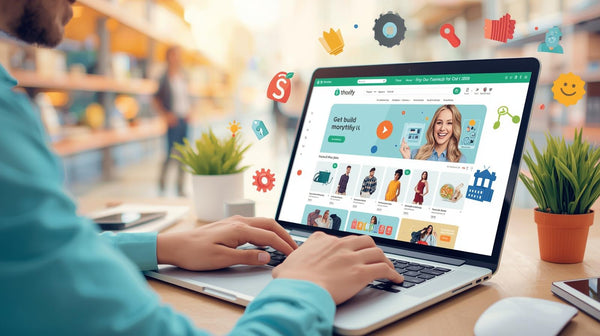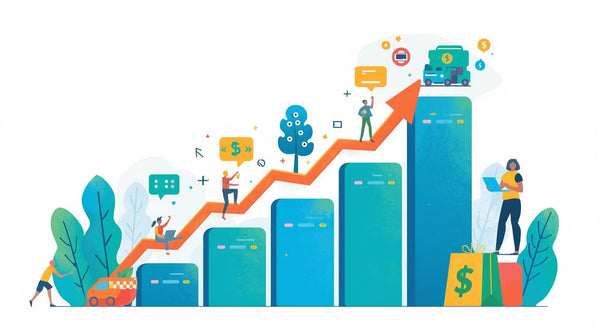Introduction Why Tags Matter in Shopify
When most Shopify owners think about growth, their attention usually goes straight to eye-catching themes, clever ad campaigns, or irresistible discounts. Those things definitely matter, but here’s the twist one of the most underrated growth tools inside Shopify is something far simpler: tags.
At first glance, tags don’t look like a game-changer. They’re just short labels you attach to products, customers, or orders. But if you look deeper, tags are much more than labels. They’re the invisible framework that helps your store stay organized, your SEO improve, and your customer experience feel smooth and professional.
Think of tags like the behind-the-scenes crew in a theater production. The audience doesn’t see them, but without them, the entire show would fall apart. In the same way, your Shopify tags quietly power a lot of the store experience from how products are found, to how discounts apply, to how customers get segmented for better marketing.
Here’s why these matters:
-
Without tags, your store gets messy fast. Customers struggle to find products, you lose efficiency managing orders, and your marketing feels one-size-fits-all.
-
With tags, everything clicks. Search results get sharper, collections stay tidy, and your store feels more personalized to every visitor.
For SEO, tags are like little signals that tell search engines what your store is about. For operations, they’re shortcuts that save you hours. And for customers, they’re invisible helpers that guide them toward the right product.
Over the next sections, we’ll break down exactly how tags work in Shopify, why they’re critical for growth, their pros and cons, and how to use them strategically. By the end, you’ll see that tags aren’t just an extra feature they’re a core asset for running a store that scales.
What Exactly Are Tags in Shopify?
So let’s strip it down: what are tags in Shopify, really?
At their core, tags are keywords or labels you can attach to different parts of your store. Think of them like sticky notes that help you keep things organized, but with a lot more power than what meets the eye. Tags make your store smarter, easier to manage, and more customer friendly.
Here’s how they work across different areas:
-
Product Tags
These are the most common. You attach tags to products to categorize them, group them into collections, or make them easier for customers to filter. For example, a clothing store might use tags like “summer,” “casual,” or “cotton.” When a shopper filters for “cotton,” those tagged products instantly show up. -
Customer Tags
Customer tags help you segment your audience. Maybe you want to separate “VIP” customers, “wholesale buyers,” or even customers acquired through a specific campaign. With the right tags, you can personalize marketing, send targeted emails, or offer discounts to specific groups. -
Order Tags
These keep fulfillment organized. You can tag orders by shipping method (like “express”), by sales channel (like “Facebook ad”), or by status (“urgent”). That way, your team knows what needs priority and can spot trends in where orders are coming from. -
Blog Tags
Blogs often get overlooked in Shopify, but blog tags make a big difference in discoverability. If you’re writing posts around “eco-friendly living” or “gift ideas,” those tags help both your visitors and search engines understand your content. This makes your blog easier to navigate and improves your SEO footprint.
In simple terms, tags in Shopify are like a secret language between you, your store, and your customers. They keep things tidy behind the scenes while quietly shaping how people interact with your business on the front end.
And here’s the kicker once you master tags, you’ll notice your store feels easier to run, your marketing feels sharper, and your customers feel more connected to your brand.
The Business Case for Tags
So why should a Shopify business owner even bother with tags? On the surface, they might feel like small details. But in reality, tags are one of those behind-the-scenes levers that simplify complexity and drive real results.
Let’s break it down:
-
They Make Large Inventories Searchable and Shoppable
Imagine you’re running a store with 200 products. Without tags, your catalog looks like a giant digital warehouse with no clear sections. Tags turn that chaos into order. A customer who wants “vegan skincare” or “red sneakers under $100” can find what they need in seconds and speed matters when it comes to conversions. -
They Supercharge Marketing Personalization
Marketing isn’t about blasting the same message to everyone anymore. With customer tags, you can separate first-time buyers from repeat customers or identify wholesale clients from retail shoppers. This allows your team to run highly targeted campaigns, like giving VIPs early access to a new collection or sending a “thank you” coupon to loyal buyers. -
They Smooth Out the Buyer Journey
When shoppers land on your store, they don’t want to scroll endlessly. Tags help them filter products quickly and discover relevant options. In fact, this simple step can be the difference between someone bouncing off your site versus sticking around long enough to purchase. -
They Keep Operations Organized
Behind the curtain, order tags help your staff manage fulfillment efficiently. For example, orders tagged “priority shipping” can be handled first, while “Instagram campaign” tags help you see which promotions are actually driving sales. This saves time, reduces mistakes, and keeps your team focused.
A Real-Life Example
Take a Shopify fashion store that started tagging its catalog with terms like “summer collection” and “under $50.” Suddenly, customers could shop by season or price point, without digging through irrelevant items. The result? Browsing became faster, customer frustration dropped, and conversion rates rose. A simple system of tags directly boosted sales.
Advantages of Using Tags in Shopify
A lot of Shopify owners underestimate tags because they look like small labels. But the truth is, a well-planned tagging strategy can completely transform how your store performs both for customers and for your internal team. Let’s unpack the real advantages:
-
SEO Value – Tags Create Structured Content and Improve Searchability
Search engines like Google thrive on structure. Tags help create a more organized site architecture, which improves crawlability and increases the chances of your products showing up in search results. For example, if you have tags like “organic cotton shirts” or “eco-friendly skincare”, you’re giving Google clearer signals about what your store sells and that can bring in more targeted organic traffic. -
Better Navigation – Customers Find Products Quicker
Nobody likes to scroll endlessly. Tags function like instant filters that cut down the time between landing on your site and finding the right product. A customer searching for “kids’ winter boots” doesn’t want to see sandals or running shoes. Tags make the shopping journey smooth, intuitive, and frustration-free. -
Efficient Segmentation – Helps Tailor Marketing Campaigns
With customer tags, you can segment your audience based on behavior or purchase history. Think of it as micro-targeting: send one email to customers tagged “first purchase” with a discount code, and another to “VIP customers” with early access to a new launch. Segmentation powered by tags means higher engagement and stronger customer relationships. -
Automation – Many Shopify Apps Use Tags to Trigger Workflows
Tags don’t just help with organization they can also save you time. Many Shopify apps rely on tags to trigger automated workflows. For instance, a loyalty program app can automatically tag customers who spend above $500, unlocking rewards. Or a fulfillment app might use order tags like “express shipping” to prioritize those orders in the queue. -
Upselling Opportunities – Highlight Top Products
Shoppers naturally gravitate toward social proof. By tagging products as “bestseller” or “trending,” you guide them toward items that others are buying. This simple psychological nudge increases the chances of upsells and boosts average order value. -
Cross-Selling Potential – Group Complementary Items
Tags can also power smart cross-selling. If a customer is browsing “yoga mats,” they can be shown related tags like “yoga straps” or “foam rollers.” This creates natural bundles, encourages customers to add more to their cart, and enhances the overall shopping experience.
Disadvantages and Common Mistakes with Tags
Now, let’s be real for a second. Tags are a fantastic tool, but they’re not a magic wand. If you don’t use them wisely, they can actually create more problems than they solve. Here are the main pitfalls that trip up many Shopify store owners:
-
Over-Tagging – Too Much of a Good Thing
It’s tempting to add dozens of tags to every product just in case one helps. But when you over-tag, you create clutter instead of clarity. Imagine a single product with 15 different tags; the system becomes harder to manage, and customers may see irrelevant categories that don’t guide them effectively. Over-tagging makes your store messy both for you and for the buyer. -
Inconsistent Naming – “T-Shirt” vs “Tee”
Consistency is everything. If you use “T-shirt” on one product and “tee” on another, you’re essentially breaking your own system. The backend doesn’t automatically know they’re the same, so your categories and filters get fragmented. This mistake is especially common in fast-growing stores where multiple people handle product uploads. Without a standard naming convention, things spiral quickly. -
SEO Confusion – Duplicate or Weak Signals
Tags can help with SEO, but if you use them carelessly, they can dilute your search signals. For instance, creating multiple tags that mean the same thing like “handbag,” “purse,” and “ladies bag” can confuse search engines about which page to prioritize. Instead of boosting rankings, duplicate or poorly thought-out tags may actually hold you back. -
Operational Overload – Complicating the Backend
A poorly managed tagging system can actually slow down your operations. If your staff has to dig through inconsistent or unnecessary tags to process orders, fulfillments, or customer segments, it creates more work instead of less. Tags are meant to simplify workflows, not add another layer of complexity.
The Fix: Simplicity and Alignment
The solution is straightforward:
-
Stick to a clear tagging strategy.
-
Keep names consistent.
-
Avoid duplicates.
-
Always align your tags with your actual business goals.
If a tag doesn’t serve a specific purpose whether SEO, navigation, or automation don’t use it.
How to Create a Tagging Strategy for Shopify
The real difference between a store that thrives with tags and one that drowns in them is strategy. Tags aren’t just random labels; they’re part of your store’s organizational DNA. If you plan them out properly, they’ll scale with you instead of becoming a burden. Here’s how to build a strong tagging strategy for your Shopify store:
-
Define Categories Upfront – Start with Purpose
Don’t wait until you’ve uploaded 200 products to think about tags. Decide right at the start what role tags will play in your store. Will they help customers filter products? Will they be used by your team to manage orders? Will they serve as triggers for automated workflows? A clear purpose means every tag has a job and tags without a job don’t belong in your system. -
Stay Consistent – Create a Shared Language
Consistency is where most businesses slip. If one team member tags an item as “jacket” while another uses “coats,” you end up with duplication and confusion. Solve this by creating a tagging style guide a simple internal document where you define standard tag terms and rules. Think of it like a dictionary for your store. This saves hours of cleanup later. -
Connect to Customer Intent – Think Like a Shopper
Tags are not just for the backend. They shape how your customers browse. Put yourself in their shoes: what terms would they actually use to search for your products? For example, customers might search “work shoes” instead of “formal footwear.” By aligning tags with real-world buyer intent, you improve discoverability and conversion rates. -
Review Regularly – Clean Up the Clutter
Tags aren’t “set it and forget it.” Over time, as your product catalog evolves, old or unused tags can pile up. Make it a practice to review your tags every few months. Retire the ones that no longer serve a purpose and refine the ones that do. Think of it as spring cleaning for your Shopify backend. -
Leverage Automation – Work Smarter, Not Harder
If you’re manually adding tags to every product or order, you’re wasting valuable time. Shopify Flow and third-party apps can automate tagging based on rules you set. For instance, every order over $200 could automatically get tagged “high value,” or all products with the vendor “Nike” could get tagged “Nike Gear.” This saves time, reduces human error, and keeps your system tight.
Bottom Line
A solid tagging strategy isn’t about having more tags it’s about having the right ones. With planning, consistency, customer focus, and automation, tags can transform from a backend afterthought into one of your most powerful business tools.
Tags and SEO – The Overlooked Connection
When people think about SEO for Shopify, they usually jump straight to product descriptions, meta titles, or backlinks. Tags rarely make it into that conversation, but they should. Tags quietly carry SEO weight, and when you use them strategically, they can become one of the easiest ways to strengthen your store’s visibility.
-
Internal Linking – Tags Build Their Own Ecosystem
Every time you create a tag in Shopify, you’re also creating a new tag page with its own URL. These pages automatically pull together all products under that tag, creating clusters of related content. That’s gold for search engines because it mimics a well-structured internal linking system. Instead of Google crawling hundreds of disconnected products, it now sees neatly grouped collections, which are easier to index and rank. -
Keyword Reinforcement – Speaking Google’s Language
Let’s say you run a skincare store. If multiple products are tagged with “organic skincare,” your tag page naturally reinforces that keyword theme. Over time, search engines pick up on the signal: this site is an authority on organic skincare. The more consistent you are, the stronger that signal becomes without you writing new blog posts or changing your site structure. -
Long-Tail SEO Opportunities – Capture the Specific Searches
Tags shine brightest when you go after long-tail keywords. Instead of broad, high-competition terms like “shoes,” think in specifics: “waterproof hiking shoes,” “vegan leather boots,” or “work shoes for standing all day.” Each tag creates a micro-page around that niche, giving you a chance to rank where competitors aren’t even looking. These long-tail searches may bring fewer visitors individually, but they’re high-intent buyers, which means better conversion rates. -
User Experience Meets SEO – The Double Win
The beauty of tags is that they improve both customer experience and search engine clarity at the same time. Customers get an easier way to browse, while Google gets neatly organized keyword-rich groupings. When the two align, you end up with more traffic that also converts better. -
Caution: Don’t Overstuff
There’s a flip side here. If you create hundreds of thin, duplicate tag pages with little value, it can dilute your SEO instead of strengthening it. Google doesn’t reward clutter. The key is to be selective: only create tags that serve a genuine purpose and are backed by relevant products.
Key Insight
Think of tags as micro-SEO assets. They’re not as big as your collections or blog posts, but they quietly build relevance and authority. Done right, they let you rank for dozens of niche searches without adding extra content a hidden advantage most Shopify owners miss.
Tags vs Collections What’s the Difference?
It’s easy to see why Shopify store owners mix up tags and collections. Both organize products, both can improve navigation, and both appear on your site. But the way they work and the benefits they bring are very different. Understanding the distinction is key to using them effectively.
-
Collections – The Big Buckets
Think of collections as the major sections of your store. They group products under broad themes like “Women’s Clothing,” “Electronics,” or “Home Decor.” Collections are ideal for showing your customers high-level categories and creating a clear shopping path. They’re also great for marketing campaigns because you can link directly to these collections in ads, emails, or social posts. -
Tags – The Finer Details
Tags live within collections and offer the nuance that collections can’t. For example, in a “Women’s Clothing” collection, tags like “linen,” “summer,” “casual,” or “under $50” allow customers to drill down and find exactly what they want. Tags are flexible, easy to adjust, and can be applied across multiple collections something collections can’t do without duplication. -
Closet Analogy – Visualize the Difference
Imagine your store as a closet: collections are your sections pants, shirts, jackets. Tags are the labels on each hanger: “cotton,” “black,” “formal,” or “sale.” Collections get people to the right part of the closet; tags help them find the exact item quickly. -
How They Work Together
The smartest Shopify stores use both strategically. Collections guide overall navigation and marketing. Tags create personalized browsing experiences and improve SEO by generating more internal linking and niche landing pages. For example, a “Summer Dresses” collection might include tags like “floral,” “maxi,” or “beachwear,” making it easier for customers to filter and for search engines to understand your product themes. -
Flexibility Advantage
Unlike collections, tags can cross boundaries. A single product can have multiple tags across different categories. This allows you to create overlapping experiences and dynamic filtering without having to recreate collections.
Key Insight
Collections set the stage; tags refine the performance. Together, they make your store easy to navigate, SEO-friendly, and highly personalized. If you ignore tags and rely only on collections, you’re leaving flexibility, discoverability, and potential sales on the table.
Measuring the Impact of Tags
Tags are only as powerful as the results they generate. Simply adding labels to products isn’t enough you need to measure their impact to ensure they’re helping both your customers and your business. Here’s how to do it effectively.
-
Product Discovery Rates
One of the first signs of a successful tagging system is whether customers can find products faster. Track how often visitors use tag-based filters or tag pages to navigate your store. If certain tags are rarely clicked, they may not align with what your customers are looking for. -
Conversion Rates
Tags can guide buyers to exactly what they want, which should improve conversion. Compare conversion rates for products that are heavily tagged versus those that aren’t. You’ll often find that well-tagged products sell faster because customers spend less time hunting for them. -
Bounce Rates
High bounce rates can indicate that visitors are frustrated or can’t find what they need. When tags are clear, consistent, and intuitive, customers stay longer on your site, explore more pages, and are more likely to make a purchase. Monitoring bounce rates on tag pages gives you insight into navigation effectiveness. -
Search Console Data
Many Shopify owners overlook the SEO potential of tags. Tag pages often generate their own URLs, which can rank in search engines. Use Google Search Console to see if tag-based pages are getting impressions, clicks, and rankings. Optimizing high-performing tags can bring in additional organic traffic. -
Pro Tip: Continuous Optimization
Analytics is your guide. Track which tags consistently attract visitors, lead to conversions, and reduce bounce rates. Remove or refine underperforming tags and consider adding new ones based on customer search behavior. Over time, this creates a dynamic tagging system that adapts to trends and shopper intent. -
Insight
Treat tags not just as labels, but as data-driven tools. Every click, conversion, and search metric tell you whether your system is working. When used strategically, tags can significantly enhance the shopping experience while also boosting your store’s SEO and revenue potential.
The Future of Tags in Shopify
Tags are no longer just simple labels they are becoming the backbone of automation, personalization, and SEO-driven growth for Shopify stores. As e-commerce technology evolves, savvy store owners are discovering that tags can do far more than organize products. When leveraged strategically, tags can improve search rankings, enhance customer experience, and drive long-term sales.
Automation Made Smarter
Modern Shopify apps and AI-powered tools allow tags to trigger automated workflows. For example:
-
Apply dynamic discounts automatically based on customer segments tagged as “VIP” or “first-time buyer.”
-
Route orders efficiently in fulfillment workflows using tags like “express shipping” or “backorder.”
-
Trigger email campaigns or push notifications for customers with specific interests or purchase histories.
SEO Optimization Through Tags
Tags contribute directly to search engine optimization:
-
Internal linking: Tag pages generate unique URLs that search engines can index, creating more entry points for organic traffic.
-
Keyword targeting: Using relevant product or content tags helps reinforce targeted keywords without creating redundant product pages.
-
Long-tail search opportunities: Tags like “organic cotton summer dress” or “eco-friendly soy candle gift set” attract niche buyers actively searching for specific products.
Personalization at Scale
Tags enable highly personalized storefront experiences:
-
Display recommended products based on tags linked to customer preferences.
-
Highlight seasonal collections or trending items automatically.
-
Deliver a tailored shopping experience without requiring manual updates for every product or customer segment.
Future-Proofing Your Shopify Store
The future of e-commerce favors stores that work smarter, not harder. Tags are low-cost, highly scalable, and integrate seamlessly with emerging AI and automation tools. Ignoring tags means missing out on a simple way to boost SEO, improve conversions, and create a frictionless shopping experience.
Insight for Store Owners
Think of tags as micro-SEO tools, micro-personalization engines, and micro-automation triggers all rolled into one. When used strategically, tags can transform your Shopify store from a static catalog into a dynamic, customer-focused platform that grows organically over time.
If you’re unsure how to set up a robust tagging system or want to explore advanced automation and SEO strategies, our team at EcomSpiders can guide you. We offer free consultations to help Shopify owners optimize tags, boost search rankings, and create a more personalized shopping experience for their customers.
Final Thoughts + Free Consultation Offer
Tags may seem small, but they’re quietly one of the strongest growth levers in Shopify. Done right, they improve SEO, streamline management, and boost customer satisfaction. Done wrong, they clutter your store and confuse buyers.
If you’re not sure whether your tagging system is helping or hurting your Shopify store, EcomSpiders can help. We specialize in optimizing every part of Shopify from SEO to automation and we offer a free consultation to get you started.





0 comments